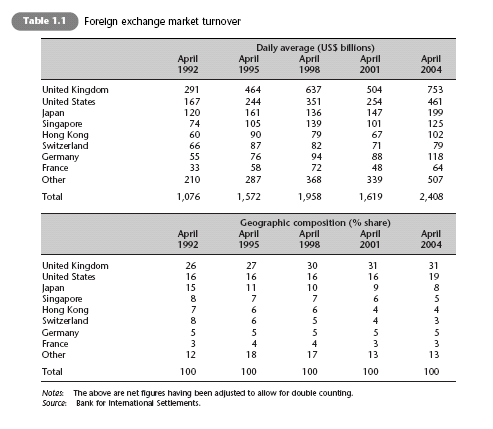Chapter 1 - The Foreign Exchange Market
Jump to Revision Questions for chapter 1
Chapter IntroductionWhen studying open economies that trade with one another, there is a major difference in the transactions between domestic and foreign residents as compared to those between residents of the same country; namely, that differing national currencies are usually involved. A US importer will generally have to pay a Japanese exporter in yen, a German exporter in euros and a British exporter in pounds. For this reason, the US importer will have to buy these currencies with dollars in what is known as the foreign exchange market. The foreign exchange market is not a single physical place, rather it is defined as a market where the various national currencies are bought and sold. Exactly what factors determine how much domestic currency has to be given in exchange to obtain a unit of foreign currency, the behaviour of exchange rates and the impact of exchange rate changes on the economy is one of the major fields of study in international economics and is the subject matter of later chapters of this book.
In this chapter, we look at some preliminary issues; we examine the various participants in the foreign exchange market and the basic forces that operate in the market.
We then examine the basic determinants of exchange rate behaviour. The chapter proceeds to examine various exchange rate definitions and their economic significance. We then look at the basic operational differences between fixed and floating exchange rate regimes. The chapter finishes by examining the relationship between the spot and forward exchange rate.
One of the most fascinating things about the foreign exchange market is the huge sums of money that are exchanged on a daily basis, Table 1.1 shows the result of surveys carried out by the Bank for International Settlements (BIS). The main centre for foreign exchange trading is London, with some $753 billion worth of foreign exchange traded on a daily basis, quite a lot when one considers that the annual gross domestic product of the United Kingdom is slightly over twice that amount. Other important foreign exchange centres are New York with $461 billion, Tokyo with $199 billion, Singapore $125 billion, Paris $64 billion and Frankfurt $118 billion. The net volume of foreign exchange dealing globally was in April 2004 estimated to be in excess of $2.4 trillion per day.

- Explain using numerical examples the difference between a nominal exchange rate index and a real exchange rate index.
- Explain using numerical examples how we construct a nominal trade weighted exchange rate index for the pound against based on hypothetical dollar per pound and euro per pound parities.
- The $/£ spot rate is $1.85/£1. The UK interest rate is 4% and the US interest rate is 1%. Calculate the six monthforward rate using the covered interest parity formula and state whether the pound is at a forward premium of discount.
- Fill in the missing values for nominal and real $/£ indexes in the table below.
| Actual | Nominal | UK Price | US Price | Real |
| Period | $/£ rate | $/£ Index | Index | Index | $/£ Index |
| 1 | $2.00/£1 | ? | 100 | 100 | ? |
| 2 | $2.20/£1 | ? | 120 | 110 | ? |
| 3 | $2.30/£1 | ? | 140 | 120 | ? |
| 4 | $2.00/£1 | ? | 120 | 140 | ? |
| 5 | $1.70/£ | ? | 150 | 150 | ? |
5. Fill in the missing values for effective pound index in the table below. Assuming that the UK does 40% of its trade with the US and 60% of its trade with Europe.
| Nominal | Nominal | Nominal (Effective) |
| Period | $/£ index | Euro/£ Index | £ Trade Weighted Index |
| 1 | 100 | 100 | ? |
| 2 | 110 | 120 | ? |
| 3 | 120 | 100 | ? |
| 4 | 80 | 120 | ? |
| 5 | 100 | 80 | ? |
6. The spot dollar-pound rate is $1.85/£1 and the one year forward rate is $1.80/£1. You expect the spot dollar-pound rate will be $1.60/£1 in one year's time. You have £1 million to speculate with.
(i) Do you buy or sell £1 million in the forward market?
(ii) What is your profit in pounds if you are correct and the spot dollar-pound rate is $1.60/£1 in one year's time?(iii) What is you loss in pounds if you are wrong and the spot sterling rate is $2.00/£1 in one years' time?




